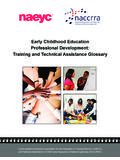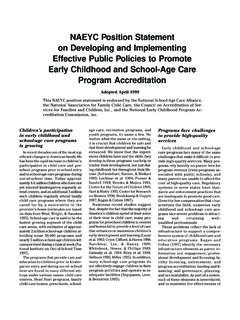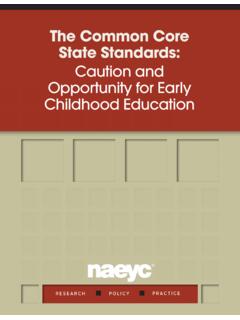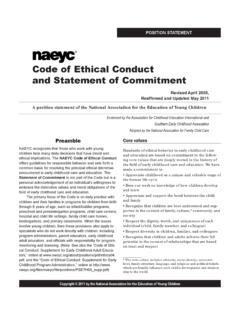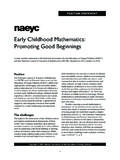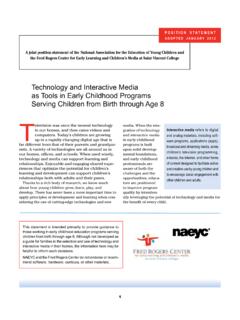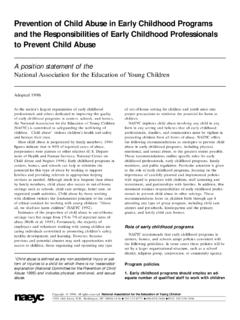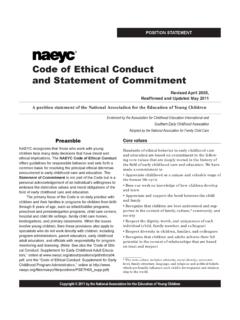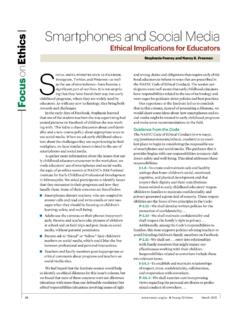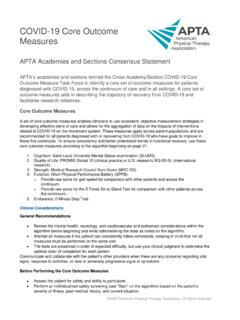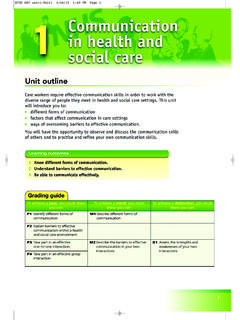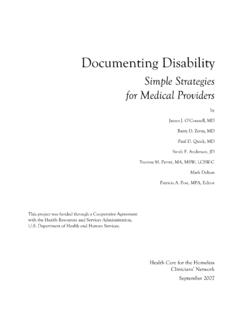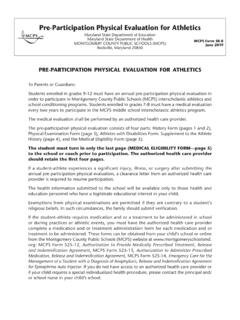Transcription of 2022 NEW OR REVISED MATERIAL IS FLAGGED ON ITEM …
1 Program Portfolio Tool NAEYC Site Visit Program Portfolio Tool Page 1 of 27 Effective January 1, 2022 Copyright 2021. National Association for the Education of Young Children. All other rights reserved. 2022 NEW OR REVISED MATERIAL IS FLAGGED ON ITEM HEADER. Revisions are shown in bold font. Program ID#: Org. ID#: Visit Date: MM/DD/YYYY Assessor ID#: Assessor Last Name: Time of PP Review Start Time: hh:mm AM/PM End Time: hh:mm AM/PM Start Time: hh:mm AM/PM End Time: hh:mm AM/PM System PP: Not a System Wide PP Bright Horizons Higher Ground Education Kiddie Academy KinderCare Learning Care Group LeafSpring New Horizon Spring Education Group Reliability Check? Yes No General Rating Guidelines: Community: The specific locality of a group of people with shared governmental, cultural, historical, social, religious, or occupational heritage. Examples of community: Military bases; workplaces; academic campuses; local business, towns; neighborhoods; residential, and recreational areas or landmarks.
2 Show or describe: When an item says "show or describe", this means that you may document the stated practice with a sample (photo, captioned photo, child work sample, form, lesson plan) OR provide a brief narrative description ( paragraph) that specifically addresses how you meet the stated practice. It is acceptable to both show AND describe, if both are needed to adequately address the stated practice. Program Portfolio Tool NAEYC Site Visit Program Portfolio Tool Page 2 of 27 Effective January 1, 2022 Copyright 2021. National Association for the Education of Young Children. All other rights reserved. Standard 1 Relationships - Building Positive Relationships between Teachers and Children I T P K S NEW GUIDANCE 2022 Show that your guidance/discipline policy states that staff may never use physical punishment, psychological abuse, or coercion when disciplining a child. The policy must include examples of prohibited staff practices.
3 Yes No Examples of physical punishment: Shaking, hitting, spanking, slapping, jerking, squeezing, kicking, biting, pinching, excessive tickling, and pulling of arms, hair, or ears; requiring a child to remain inactive for a long period of time. Examples of psychological abuse: shaming, name calling, ridiculing, humiliation, sarcasm, cursing at, making threats, or frightening a child; ostracism, withholding affection, seclusion. Examples of coercion: Rough handling (shoving, pulling, pushing, grasping any body part); physical restraint (forcing a child to sit down, lie down, or stay down) except when restraint is necessary to protect the child or others from harm; physically forcing a child to perform an action (such as eating or cleaning up). NOTE: The use of a physical escort as defined below and properly used when necessary to protect the child or others from harm is NOT coercion. Mechanical restraint: the use of devices as a means of restricting a student s freedom of movement.
4 ( 7124, 2018) Physical escort: the temporary touching or holding of the hand, wrist, arm, shoulder , or back for the purpose of inducing a student who is acting out to walk to a safe location. ( 7124, 2018) Physical restraint: a personal restriction that immobilizes or reduces the ability of an individual to move the individual s arms, legs, torso, or head freely, except that such term does not include a physical escort, mechanical restraint, or chemical restraint. ( 7124, 2018) Seclusion: the involuntary confinement of a student alone in a room or area from which the student is physically prevented from leaving, except that such term does not include a time out. ( 7124, 2018) I T P K S Show how your guidance/discipline policy is communicated to all staff. Yes No I T P K S NEW GUIDANCE 2022 REQUIRED This is a required item. If the assessor determines that this item is not fully met at the time of the site visit, the program will NOT be granted accreditation.
5 Programs may appeal the determination to the Quality Assurance Committee of the Council on NAEYC Accreditation. Show that your guidance/discipline policy does not include any circumstances when it is permissible for staff to use any form of physical punishment, psychological abuse, or coercion when disciplining a child. Appropriate use of restraint for safety reasons is permissible. Yes No See examples and definitions accompanying , which apply to this item as well. Program Portfolio Tool NAEYC Site Visit Program Portfolio Tool Page 3 of 27 Effective January 1, 2022 Copyright 2021. National Association for the Education of Young Children. All other rights reserved. Addressing Challenging Behaviors I T P K S NEW ITEM LANGUAGE & GUIDANCE 2022 Show that your program s written guidance and discipline policy addresses the use of suspension, expulsion and other exclusionary measures (seclusion), and includes ALL of the features listed below.
6 Policy is communicated to families and staff. Stated goal of policy is to limit or eliminate the use of suspension, expulsion and other exclusionary measures. Policy states the circumstances under which types of exclusion may occur. Policy states what steps are taken before a decision to exclude is considered. Exclusionary measures are not considered until all other possible interventions have been exhausted, and there is agreement that exclusion is in the best interest of the child. If exclusionary measures must be taken, the program offers assistance to the family in accessing services and an alternative placement. Policy acknowledges that it complies with federal and state civil rights laws. Yes No Seclusion: the involuntary confinement of a student alone in a room or area from which the student is physically prevented from leaving, except that such term does not include a time out.
7 ( 7124, 2018) Standard 2 Curriculum - Curriculum: Essential Characteristics I T P K S NEW GUIDANCE 2022 Show or describe one example of how your program has changed classroom materials or equipment to accommodate the individual needs of a child. Yes No Individual needs: Needs that arise from adverse life conditions (such as poverty or family stress) that call for social services, supports, or monitoring; children with disabilities are also accommodated within the scope of this assessment item. Disabilities: Physical or mental health conditions that require special education services, such as early intervention or individualized supports. I T P K S Show two examples of how your written curriculum or curriculum framework can be modified to reflect the values, beliefs, and experiences of families in your program. Yes No Written curriculum/curriculum framework: Includes the goals for the knowledge and skills to be acquired by children and the plans for learning experiences through which such knowledge and skills will be achieved.
8 I T P K S Show one example of how your written curriculum or curriculum framework can be modified to reflect the languages spoken by families in the program. Yes No Written curriculum/curriculum framework: Includes the goals for the knowledge and skills to be acquired by children and the plans for learning experiences through which such knowledge and skills will be achieved. Program Portfolio Tool NAEYC Site Visit Program Portfolio Tool Page 4 of 27 Effective January 1, 2022 Copyright 2021. National Association for the Education of Young Children. All other rights reserved. I T P K S Show that your written curriculum or curriculum framework shows teachers how they can use child assessment information to individualize learning plans. Yes No Written curriculum/curriculum framework: Includes the goals for the knowledge and skills to be acquired by children and the plans for learning experiences through which such knowledge and skills will be achieved.
9 - Areas of Development: Language Development I T P K S Show or describe how you incorporate family language preferences into the curriculum. Yes No Family language preferences: pronouns, vocabulary, and other terminology unique to a specific family. This may include non-English words or phrases used by a family. Examples of family language preferences: Preferred family terminology for body parts (anatomical or other terms), bodily functions (go potty, pee-pee, tinkle, poop, bowel movement, tummy-trouble), or familial relationships (nana, oma, m imei, daddy, papa, grandp re, ate). I T P K S Show or describe how your curriculum related to language acquisition considers community perspectives. Yes No Curriculum Content Area for Cognitive Development: Social Studies I T P K S Show or describe two examples of how your program educates families on eco-healthy practices. Yes No Eco-healthy practices: Choices of furnishings, materials, supplies, and procedures that eliminate or reduce people s (children, staff, families) exposure to environmental health hazards such as unhealthy air, heavy metals, and chemicals.
10 Examples of eco-healthy practices: Washing fruits and vegetables before consumption; purchasing non-toxic toys and art supplies; recycling; monitoring daily outdoor air quality; using least-toxic, fragrance-free cleaning products. Program Portfolio Tool NAEYC Site Visit Program Portfolio Tool Page 5 of 27 Effective January 1, 2022 Copyright 2021. National Association for the Education of Young Children. All other rights reserved. Standard 3 Teaching - Creating Caring Communities for Learning I T P K S When a child s ongoing challenging behavior must be addressed, show a written policy including these steps: Assess the function of the behavior Work with families and professionals to develop an individualized plan to address the behavior Include positive behavior support strategies as part of the plan. Yes No Challenging behavior: "Any behavior that (1) interferes with children's learning, development and success at play, (2) is harmful to the child, other children, or adults, [or] (3) puts a child at high risk for later social problems or school failure.
